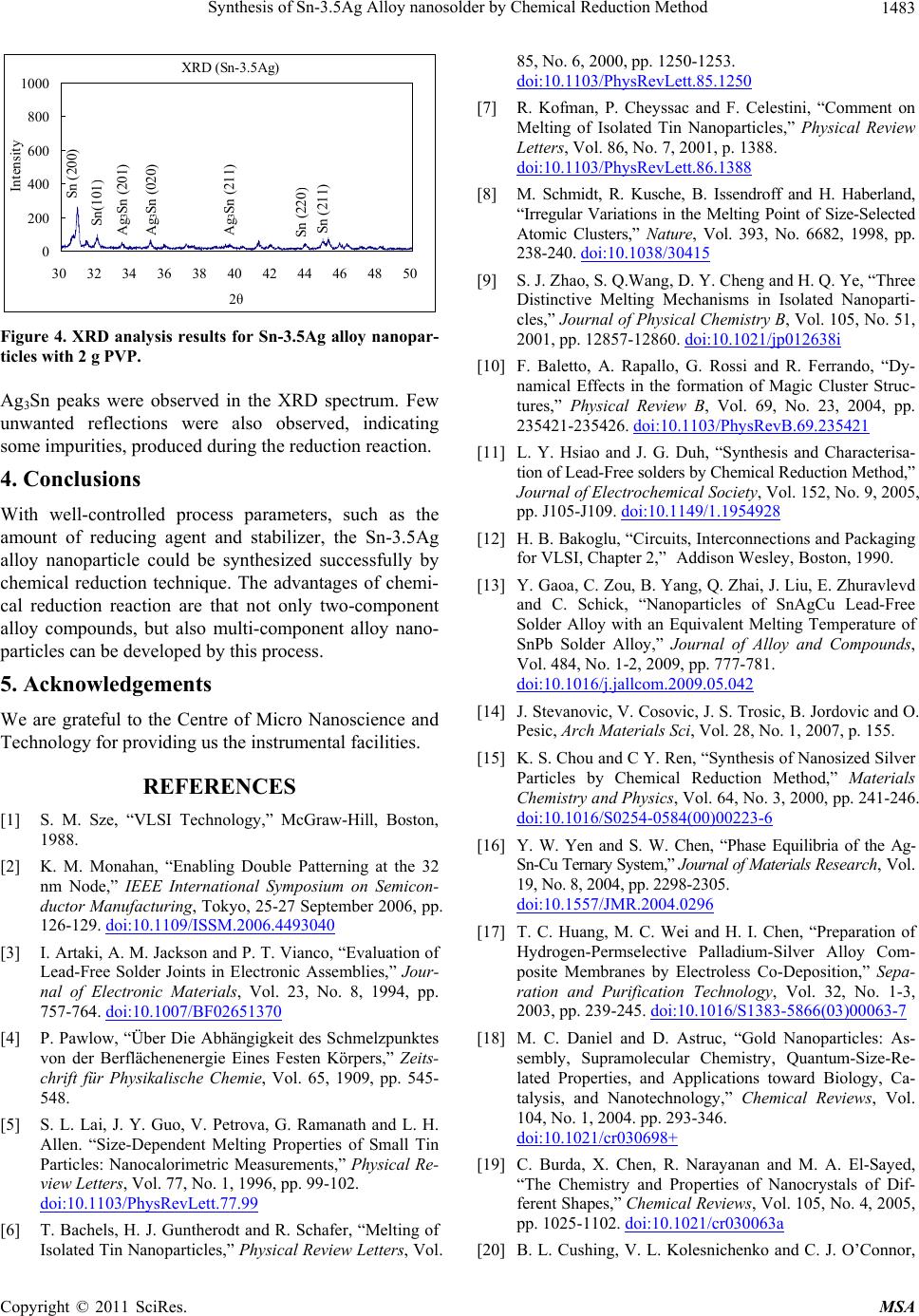
Synthesis of Sn-3.5Ag Alloy nanosolder by Chemical Reduction Method1483
XRD (Sn-3.5Ag)
0
200
400
600
800
1000
30 32 34 36 38 40 42 44 46 48 50
2θ
Intensity
Sn(101
Ag3Sn (201)
Ag3Sn (020)
Ag3Sn (211)
Sn (220
Sn (211
Sn (200
Figure 4. XRD analysis results for Sn-3.5Ag alloy nanopar-
ticles with 2 g PVP.
Ag3Sn peaks were observed in the XRD spectrum. Few
unwanted reflections were also observed, indicating
some impurities, produced during the reduction reaction.
4. Conclusions
With well-controlled process parameters, such as the
amount of reducing agent and stabilizer, the Sn-3.5Ag
alloy nanoparticle could be synthesized successfully by
chemical reduction technique. The advantages of chemi-
cal reduction reaction are that not only two-component
alloy compounds, but also multi-component alloy nano-
particles can be developed by this process.
5. Acknowledgements
We are grateful to the Centre of Micro Nanoscience and
Technology for providing us the instrumental facilities.
REFERENCES
[1] S. M. Sze, “VLSI Technology,” McGraw-Hill, Boston,
1988.
[2] K. M. Monahan, “Enabling Double Patterning at the 32
nm Node,” IEEE International Symposium on Semicon-
ductor Manufacturing, Tokyo, 25-27 September 2006, pp.
126-129. doi:10.1109/ISSM.2006.4493040
[3] I. Artaki, A. M. Jackson and P. T. Vianco, “Evaluation of
Lead-Free Solder Joints in Electronic Assemblies,” Jour-
nal of Electronic Materials, Vol. 23, No. 8, 1994, pp.
757-764. doi:10.1007/BF02651370
[4] P. Pawlow, “Über Die Abhängigkeit des Schmelzpunktes
von der Berflächenenergie Eines Festen Körpers,” Zeits-
chrift für Physikalische Chemie, Vol. 65, 1909, pp. 545-
548.
[5] S. L. Lai, J. Y. Guo, V. Petrova, G. Ramanath and L. H.
Allen. “Size-Dependent Melting Properties of Small Tin
Particles: Nanocalorimetric Measurements,” Physical Re-
view Letters, Vol. 77, No. 1, 1996, pp. 99-102.
doi:10.1103/PhysRevLett.77.99
[6] T. Bachels, H. J. Guntherodt and R. Schafer, “Melting of
Isolated Tin Nanoparticles,” Physical Review Letters, Vol.
85, No. 6, 2000, pp. 1250-1253.
doi:10.1103/PhysRevLett.85.1250
[7] R. Kofman, P. Cheyssac and F. Celestini, “Comment on
Melting of Isolated Tin Nanoparticles,” Physical Review
Letters, Vol. 86, No. 7, 2001, p. 1388.
doi:10.1103/PhysRevLett.86.1388
[8] M. Schmidt, R. Kusche, B. Issendroff and H. Haberland,
“Irregular Variations in the Melting Point of Size-Selected
Atomic Clusters,” Nature, Vol. 393, No. 6682, 1998, pp.
238-240. doi:10.1038/30415
[9] S. J. Zhao, S. Q.Wang, D. Y. Cheng and H. Q. Ye, “Three
Distinctive Melting Mechanisms in Isolated Nanoparti-
cles,” Journal of Physical Chemistry B, Vol. 105, No. 51,
2001, pp. 12857-12860. doi:10.1021/jp012638i
[10] F. Baletto, A. Rapallo, G. Rossi and R. Ferrando, “Dy-
namical Effects in the formation of Magic Cluster Struc-
tures,” Physical Review B, Vol. 69, No. 23, 2004, pp.
235421-235426. doi:10.1103/PhysRevB.69.235421
[11] L. Y. Hsiao and J. G. Duh, “Synthesis and Characterisa-
tion of Lead-Free solders by Chemical Reduction Method,”
Journal of Electrochemical Society, Vol. 152, No. 9, 2005,
pp. J105-J109. doi:10.1149/1.1954928
[12] H. B. Bakoglu, “Circuits, Interconnections and Packaging
for VLSI, Chapter 2,” Addison Wesley, Boston, 1990.
[13] Y. Gaoa, C. Zou, B. Yang, Q. Zhai, J. Liu, E. Zhuravlevd
and C. Schick, “Nanoparticles of SnAgCu Lead-Free
Solder Alloy with an Equivalent Melting Temperature of
SnPb Solder Alloy,” Journal of Alloy and Compounds,
Vol. 484, No. 1-2, 2009, pp. 777-781.
doi:10.1016/j.jallcom.2009.05.042
[14] J. Stevanovic, V. Cosovic, J. S. Trosic, B. Jordovic and O.
Pesic, Arch Materials Sci, Vol. 28, No. 1, 2007, p. 155.
[15] K. S. Chou and C Y. Ren, “Synthesis of Nanosized Silver
Particles by Chemical Reduction Method,” Materials
Chemistry and Physics, Vol. 64, No. 3, 2000, pp. 241-246.
doi:10.1016/S0254-0584(00)00223-6
[16] Y. W. Yen and S. W. Chen, “Phase Equilibria of the Ag-
Sn-Cu Ternary System,” Journal of Materials Research, Vol.
19, No. 8, 2004, pp. 2298-2305.
doi:10.1557/JMR.2004.0296
[17] T. C. Huang, M. C. Wei and H. I. Chen, “Preparation of
Hydrogen-Permselective Palladium-Silver Alloy Com-
posite Membranes by Electroless Co-Deposition,” Sepa-
ration and Purification Technology, Vol. 32, No. 1-3,
2003, pp. 239-245. doi:10.1016/S1383-5866(03)00063-7
[18] M. C. Daniel and D. Astruc, “Gold Nanoparticles: As-
sembly, Supramolecular Chemistry, Quantum-Size-Re-
lated Properties, and Applications toward Biology, Ca-
talysis, and Nanotechnology,” Chemical Reviews, Vol.
104, No. 1, 2004. pp. 293-346.
doi:10.1021/cr030698+
[19] C. Burda, X. Chen, R. Narayanan and M. A. El-Sayed,
“The Chemistry and Properties of Nanocrystals of Dif-
ferent Shapes,” Chemical Reviews, Vol. 105, No. 4, 2005,
pp. 1025-1102. doi:10.1021/cr030063a
[20] B. L. Cushing, V. L. Kolesnichenko and C. J. O’Connor,
Copyright © 2011 SciRes. MSA